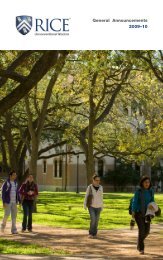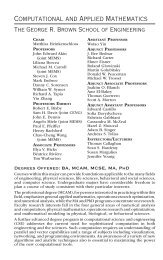Sallyport - The Magazine of Rice University - Winter 2002
Sallyport - The Magazine of Rice University - Winter 2002
Sallyport - The Magazine of Rice University - Winter 2002
You also want an ePaper? Increase the reach of your titles
YUMPU automatically turns print PDFs into web optimized ePapers that Google loves.
<strong>The</strong> Eyes Have It - Through the <strong>Sallyport</strong><br />
<strong>Winter</strong> <strong>2002</strong><br />
VOL.58, NO.2<br />
<strong>The</strong> Eyes Have It<br />
When a new window or webpage pops up on your computer screen, what<br />
do you look at first? Michael Byrne, assistant pr<strong>of</strong>essor <strong>of</strong> psychology at<br />
<strong>Rice</strong>, might be able to tell you. He has developed a model <strong>of</strong> human<br />
thinking and performance that can predict how well people locate and<br />
select various options on a computer screen. <strong>The</strong> model has implications for<br />
designing air-traffic-control monitors, in-car navigation systems, webpages,<br />
and other computer displays to present on-screen information most<br />
effectively to the viewer.<br />
“Our theory and model allow scientists to make predictions about human<br />
performance on tasks that involve computer displays,” says Byrne. “We can<br />
tell, for example, where to position information on a computer screen so<br />
that the user is more likely to see it quickly.” Byrne conducted the research<br />
at Carnegie Mellon <strong>University</strong> before joining the faculty at <strong>Rice</strong>, where he<br />
analyzed the results that are published in the July issue <strong>of</strong> the International<br />
Journal <strong>of</strong> Human Computer Studies.<br />
“Understanding the interaction <strong>of</strong> a user with a designed device like a<br />
computer requires a clear understanding <strong>of</strong> three components,” Byrne says.<br />
“<strong>The</strong> user’s cognitive, perceptual, and motor capabilities; the task; and the<br />
device used to accomplish the task can impact the result.”<br />
Byrne showed each <strong>of</strong> the 11 participants in his study more than 100<br />
questions that involved identifying a particular number or letter in lists <strong>of</strong><br />
random numbers and letters on a computer screen. He timed how long it<br />
took the participants to spot the selected symbols. A camera mounted on a<br />
headband worn by the participants tracked their eye movements.<br />
Using a theory <strong>of</strong> cognition known as ACT-R/PM and an eye-tracking<br />
model, Byrne predicted how long it would take the participants to click on<br />
the targeted items. He also predicted the other items they would look at en<br />
route to the targeted items, based on the characters or numbers they were<br />
likely to fixate on and the order in which they were likely to read<br />
information on the display. Byrne found that his predictions averaged<br />
within 15 percent <strong>of</strong> participants’ actual response times—“close enough to<br />
be useful to designers,” he says.<br />
Engineers who design air-traffic-control monitors, for example, could use<br />
the theory and model to position critical information on a screen where the<br />
user is most likely to see it first. “Keeping up with the volume <strong>of</strong><br />
information on a computer display is <strong>of</strong>ten a problem,” Byrne said. “A<br />
designer can optimize the rate at which people can process information on<br />
the screen by using the theory and model we studied. A strategic placement<br />
<strong>of</strong> menu items can make it possible for people to read the most important<br />
information fast enough to keep up with their work so they don’t end up in<br />
a situation where they’re likely to make errors.”<br />
Byrne’s research was supported by the National Science Foundation, the<br />
Office <strong>of</strong> Naval Research, the National Institute <strong>of</strong> Mental Health, and<br />
http://www.rice.edu/sallyport/<strong>2002</strong>/winter/sallyport/theeyeshaveit.html (1 <strong>of</strong> 2) [10/30/2009 11:00:36 AM]
















